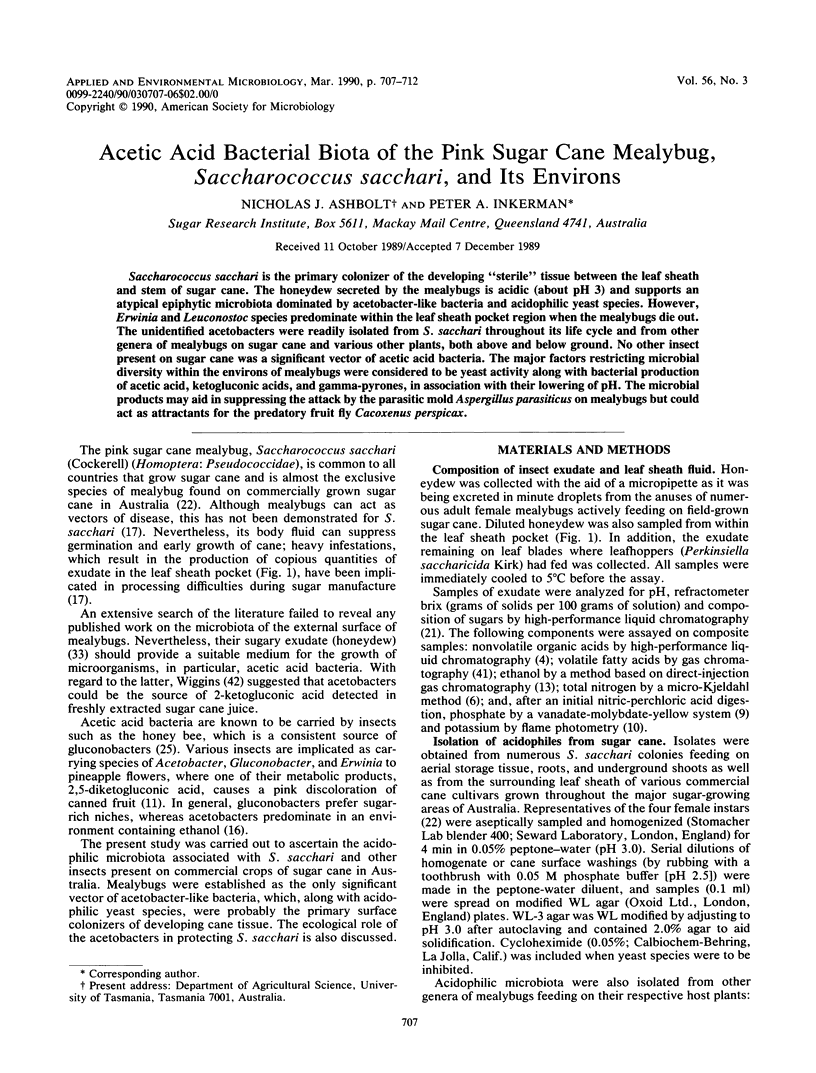Abstract
Saccharococcus sacchari is the primary colonizer of the developing “sterile” tissue between the leaf sheath and stem of sugar cane. The honeydew secreted by the mealybugs is acidic (about pH 3) and supports an atypical epiphytic microbiota dominated by acetobacter-like bacteria and acidophilic yeast species. However, Erwinia and Leuconostoc species predominate within the leaf sheath pocket region when the mealybugs die out. The unidentified acetobacters were readily isolated from S. sacchari throughout its life cycle and from other genera of mealybugs on sugar cane and various other plants, both above and below ground. No other insect present on sugar cane was a significant vector of acetic acid bacteria. The major factors restricting microbial diversity within the environs of mealybugs were considered to be yeast activity along with bacterial production of acetic acid, ketogluconic acids, and gamma-pyrones, in association with their lowering of pH. The microbial products may aid in suppressing the attack by the parasitic mold Aspergillus parasiticus on mealybugs but could act as attractants for the predatory fruit fly Cacoxenus perspicax.
Full text
PDF





Selected References
These references are in PubMed. This may not be the complete list of references from this article.
- Cho J. J., Hayward A. C., Rohrbach K. G. Nutritional requirements and biochemical activities of pineapple pink disease bacterial strains from Hawaii. Antonie Van Leeuwenhoek. 1980;46(2):191–204. doi: 10.1007/BF00444074. [DOI] [PubMed] [Google Scholar]
- Curry A. S., Walker G. W., Simpson G. S. Determination of ethanol in blood by gas chromatography. Analyst. 1966 Nov;91(88):742–743. doi: 10.1039/an9669100742. [DOI] [PubMed] [Google Scholar]
- Lambert B., Kersters K., Gosselé F., Swings J., De Ley J. Gluconobacters from honey bees. Antonie Van Leeuwenhoek. 1981;47(2):147–157. doi: 10.1007/BF02342197. [DOI] [PubMed] [Google Scholar]
- MARMUR J., DOTY P. Determination of the base composition of deoxyribonucleic acid from its thermal denaturation temperature. J Mol Biol. 1962 Jul;5:109–118. doi: 10.1016/s0022-2836(62)80066-7. [DOI] [PubMed] [Google Scholar]
- Miller K. J., Kennedy E. P., Reinhold V. N. Osmotic adaptation by gram-negative bacteria: possible role for periplasmic oligosaccharides. Science. 1986 Jan 3;231(4733):48–51. doi: 10.1126/science.3941890. [DOI] [PubMed] [Google Scholar]
- Rennie R. J. A single medium for the isolation of acetylene-reducing (dinitrogen-fixing) bacteria from soils. Can J Microbiol. 1981 Jan;27(1):8–14. doi: 10.1139/m81-002. [DOI] [PubMed] [Google Scholar]
- Starr M. P., Mandel M. DNA base composition and taxonomy of phyopathogenic and other enterobacteria. J Gen Microbiol. 1969 Apr;56(1):113–123. doi: 10.1099/00221287-56-1-113. [DOI] [PubMed] [Google Scholar]
- Ushijima T., Takahashi M., Ozaki Y. Acetic, propionic, and oleic acid as the possible factors influencing the predominant residence of some species of Propionibacterium and coagulase-negative Staphylococcus on normal human skin. Can J Microbiol. 1984 May;30(5):647–652. doi: 10.1139/m84-096. [DOI] [PubMed] [Google Scholar]
- Vreman H. J., Dowling J. A., Raubach R. A., Weiner M. W. Determination of acetate in biological material by vacuum microdistillation and gas chromatography. Anal Chem. 1978 Jul;50(8):1138–1141. doi: 10.1021/ac50030a033. [DOI] [PubMed] [Google Scholar]


